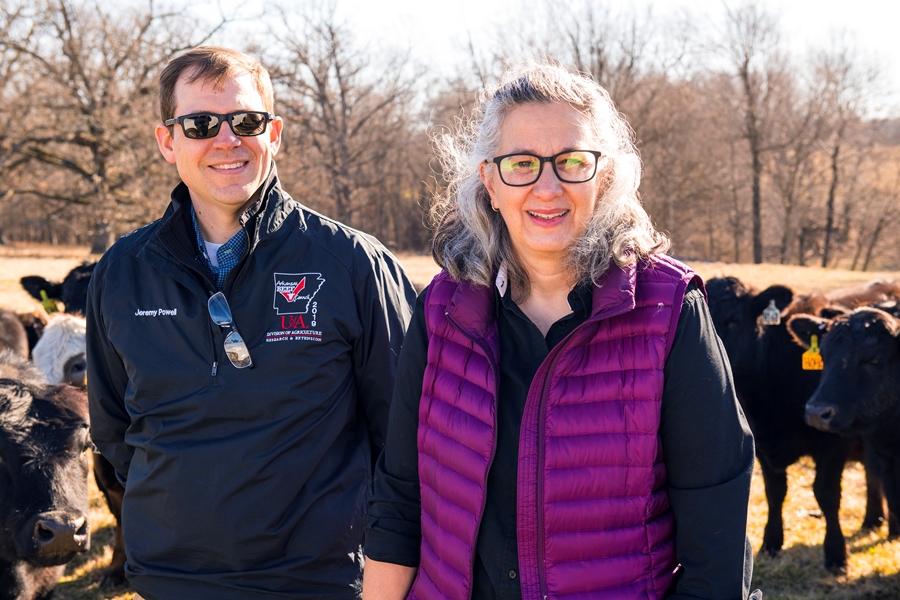Phosphorus Supplements May Not Be Needed for Heifers Grazing High-P Pastures

Animal scientists Beth Kegley, right, and Jeremy Powell are evaluating the phosphorus supplement needs of heifers grazing pastures with high soil test phosphorus.
Cattle grazing pastures with high soil-test phosphorus may be getting enough of the nutrient from the grass to eliminate the need for a phosphorus feed additive, according to Arkansas Agricultural Experiment Station research.
"Phosphorus is necessary for developing heifers," said Beth Kegley, professor of animal science for the Arkansas Agricultural Experiment Station, the research arm of the University of Arkansas System Division of Agriculture. "It's important for all energy needs, metabolism, bone growth, fertility and other uses."
In many areas of the state, especially in northwest Arkansas, farms often have both beef cattle and poultry operations, said Jeremy Powell, professor of animal science and Kegley's co-investigator.
"There has been an increase in phosphorus concentrations in soils where livestock and poultry manure have been repeatedly applied to grazing pastures or hay meadows," Powell said. "Consequently, forages grown on soils high in phosphorus tend to contain high amounts of the mineral itself."
Powell said that phosphorus is an expensive ingredient in the cost of regular mineral supplementation of beef cattle. He and Kegley investigated whether it was necessary to supplement phosphorus in areas where those concentrations, often referred to as soil-test P, were high.
"The objective of this research was to examine the effects of phosphorus intake from grazing on beef heifer growth performance and conception rates," Kegley said.
The study used two sets of 72 crossbred Angus heifers over two years, each distributed into eight groups according to weight about 30 days after weaning. They fed a control group a supplemental mineral mix that had no phosphorus. The others got an identical diet except with the addition of 4 percent supplemental phosphorus in the mineral mix.
All the heifers grazed mixed grass pastures with a history of livestock and poultry manure application that resulted in soil-test P levels of more than 130 parts per million. The research team also supplemented the animals' forage diet with 0.5 percent of their body weight in soy hulls.
Kegley said they measured the animals' body weights throughout the study. The researchers collected reproductive tract score data before the breeding season and pregnancy data following a two-month breeding season.
Kegley said mineral intake throughout the study did not differ between the animals that received phosphorus supplements and those that did not. Also, reproductive tract scores, measured by ultrasound twice during the study, did not vary significantly between the two groups. Pregnancy rates were similar for the control group that did not receive supplemental phosphorus at 79 percent versus 80 percent for the group that received the supplemental phosphorus.
"The results showed phosphorus supplementation of developing beef heifers for about 300 days following weaning and throughout the breeding season did not improve growth or reproduction when the heifers were grazing pastures with a history of livestock or poultry manure application, Kegley said.
"For Arkansas, the beef cattle inventory was about 800,000 head in 2020," Powell said. "Theoretically, if replacement heifers were approximately 20 percent of the total cowherd in the state, that would be 160,000 developing heifers.
"The reduction of cost of the mineral supplementation for this period was about $8.10 per head, potentially reducing the annual cost more than $1.29 million for the development of the Arkansas beef heifer replacement herd," Powell said.
To learn more about Division of Agriculture research, visit the Arkansas Agricultural Experiment Station website: https://aaes.uada.edu/. Follow us on Twitter at @ArkAgResearch. To learn more about the Division of Agriculture, visit https://uada.edu/. Follow us on Twitter at @AgInArk.
About the Division of Agriculture
The University of Arkansas System Division of Agriculture's mission is to strengthen agriculture, communities, and families by connecting trusted research to the adoption of best practices. Through the Agricultural Experiment Station and the Cooperative Extension Service, the Division of Agriculture conducts research and extension work within the nation's historic land grant education system.
The Division of Agriculture is one of 20 entities within the University of Arkansas System. It has offices in all 75 counties in Arkansas and faculty on five system campuses.
The University of Arkansas System Division of Agriculture offers all its Extension and Research programs and services without regard to race, color, sex, gender identity, sexual orientation, national origin, religion, age, disability, marital or veteran status, genetic information, or any other legally protected status, and is an Affirmative Action/Equal Opportunity Employer.
Topics
Contacts
Fred Miller, agricultural communications
University of Arkansas Division of Agriculture
479-575-5647,
fmiller@uark.edu
Headlines
Four Students Named Goldwater Scholars; Two Earn Udall Honorable Mentions
Four U of A students have received the prestigious Goldwater Scholarship, an award for top students in mathematics, science, and engineering.
Cross-Campus Collaboration Culminates in New Outdoor Geological Installation
Grand opening event to celebrate the new GeoLab installation at the U of A’s Gearhart Hall courtyard is set for May 3. The installation will be open to the public year-round.
First Students to Use Online Degree to Hone Nursing Leadership, Elevate Patient Care
Hanna Baxendale and Wendi Kimbrell will begin coursework in the Doctor of Nursing Practice-Executive Master of Business Administration program offered by the Eleanor Mann School of Nursing and Walton College.
Join the Office for Sustainability on a Final Cruise to Campus
Cruise to Campus Wednesdays have fostered a gathering space for individuals interested in biking to campus. Drop by the Old Main Lawn from 7:30-10 a.m. Wednesday for coffee, something to eat and conversation.
Fay Jones School Student Ambassador Program Gives Voice to Design Students
The student ambassador program at the Fay Jones School of Architecture and Design is built to connect top design students with their school, its alumni, its future students and others inside and outside the school.




